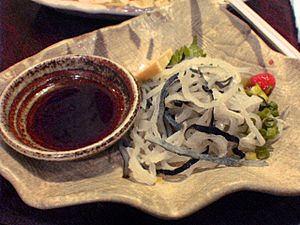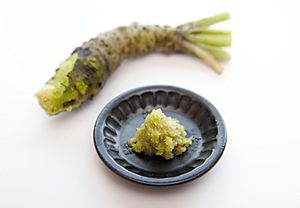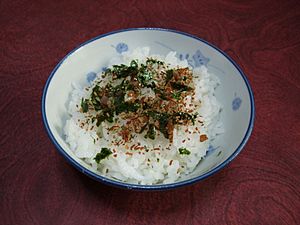List of Japanese condiments facts for kids
Japanese food is super yummy, and a big reason why is because of the special condiments they use! Condiments are things like sauces, spices, or toppings that you add to your food to make it taste even better. Think of ketchup or mustard – those are condiments! In Japan, they have many unique ones that add amazing flavors to their dishes.
Basic Japanese Condiments
Mirin: Sweet Cooking Wine
Mirin is a really important ingredient in Japanese cooking. It's a type of sweet rice wine that's a bit like sake, but it has less alcohol.
There are a few kinds of mirin:
- Hon mirin is the "true" mirin and has the most alcohol.
- Shio mirin also has alcohol but includes some salt. The salt helps avoid certain taxes on alcoholic drinks.
- Shin mirin (or "new mirin") has almost no alcohol, but it still tastes the same!
Rice Vinegar: Mild and Mellow
Rice vinegar is a gentle and smooth type of vinegar. It can be clear or a pale yellow color.
There are two main kinds of Japanese rice vinegar:
- One is made from fermented rice.
- The other is called awasezu, or seasoned rice vinegar. This one has sake, salt, and sugar added to it.
Seasoned rice vinegar is super important for making sushi rice. It's also used in salad dressings, like ginger or sesame dressing, which are popular in many places. You can mix plain rice vinegar with salt and sugar at home to make your own sushi vinegar!
Soy Sauce: The Flavorful Fermented Sauce
Soy sauce, also known as shōyu, is a famous sauce made from soybeans, roasted grain, water, and salt. It's made through a process called fermentation, which means good tiny living things help change the ingredients over time.
Japanese soy sauces often have wheat in them. This gives them a slightly sweeter taste than some other soy sauces. Soy sauce first came to Japan in the 7th century. The word "tamari" comes from a Japanese word meaning "to accumulate." This is because tamari was traditionally a liquid that collected during the making of miso paste. Japan is a big producer of tamari.
Japanese Sauces and Pastes
Karashi: Spicy Mustard
Karashi is a type of mustard used in Japanese food. It's made from crushed mustard seeds. Sometimes, it's mixed with wasabi or horseradish to make it even spicier! Karashi is usually not sweet or watery.
You'll often find karashi served with dishes like fish tempura, tonkatsu (fried pork cutlet), oden (a stew), nattō (fermented soybeans), and gyōza (dumplings). It's almost always served with pickled Japanese eggplant. Sometimes, karashi is the only condiment you need, or it might be served alongside wasabi.
Mentsuyu: Dipping Sauce Delight
Mentsuyu (めんつゆ) is a sauce made from dashi (a Japanese broth), soy sauce, mirin, and sugar. It's most often used as a dipping sauce for cold noodles like sōmen, soba, udon, and hiyamugi.
Ponzu: Zesty Citrus Sauce

Ponzu is a citrus-based sauce that's very popular in Japanese cooking. It tastes quite tart and is thin and light brown.
When soy sauce is added to ponzu, it's called ponzu shōyu. Many people just call this mix "ponzu." It's made by boiling mirin, rice vinegar, katsuobushi flakes (dried bonito), and seaweed (konbu). After cooling and straining, juices from citrus fruits like yuzu, sudachi, daidai, kabosu, or lemon are added.
Rayu: Chili Oil with a Kick
Rayu is a type of chili oil made by infusing vegetable oil with chili peppers. It's used in Chinese cuisine for cooking or as a condiment. The oil is usually sesame oil, and red chili peppers give it a reddish color. Other ingredients like soy oil, corn oil, ginger, or paprika might also be added.
Warishita: Sukiyaki's Secret Sauce
Warishita is a Japanese sauce that includes salt, sugar, and soy sauce. It's often used when preparing dishes like sukiyaki, a delicious hot pot meal.
Wasabi: Japanese Horseradish

Wasabi is a plant related to cabbage, horseradish, and mustard. It's often called "Japanese horseradish." The root of the wasabi plant is used as a spice and has a super strong flavor. Its spiciness is more like a hot mustard than the heat from a chili pepper. It makes your nose tingle more than your tongue! Wasabi grows naturally along mountain rivers in Japan.
Wasabi is usually sold in two ways:
- As a fresh root that you grate very finely before using.
- As a ready-to-use paste, often in tubes like toothpaste. This paste is usually made from horseradish, mustard, and food coloring because real fresh wasabi is expensive and spoils quickly.
Once the paste is ready, it should stay covered until you serve it. This helps keep its strong flavor from disappearing. That's why sushi chefs often put wasabi between the fish and the rice in sushi!
Popular Toppings
Furikake: Rice Seasoning
Furikake is a dry Japanese condiment. It's meant to be sprinkled on top of plain rice. It's usually a mix of dried and ground fish, sesame seeds, chopped seaweed, sugar, salt, and monosodium glutamate (MSG), which enhances flavor. Other tasty things like katsuobushi (dried bonito fish flakes), salmon, shiso (a leafy herb), egg, and vegetables are often added too.
Mayonnaise: A Japanese Twist
Mayonnaise in Japan is often made with apple cider vinegar or rice vinegar and a little bit of MSG. This gives it a different flavor than mayonnaise made with other vinegars. It usually comes in soft plastic squeeze bottles and is thinner than most mayonnaise you might find in Western countries. You can also find a version with karashi (Japanese mustard) mixed in.
Besides salads, Japanese mayonnaise is popular with dishes like okonomiyaki (savory pancake), takoyaki (octopus balls), and yakisoba (fried noodles). It often goes with katsu (fried cutlets) and karaage (fried chicken). Sometimes, it's served with cooked vegetables or mixed with soy sauce or wasabi to make dipping sauces. In some parts of Japan, it's even used on pizza instead of tomato sauce!
Menma: Bamboo Topping
Menma is a Japanese condiment made from dried bamboo. It's a common topping for noodle soup and ramen. Menma used to be called shinachiku, but that name is not used much anymore.
Wafu Dressing: Japanese-Style Salad Dressing
Wafu dressing is a type of vinaigrette salad dressing that's very popular in Japan. Its name literally means "Japanese-style dressing." The basic wafu dressing is a mix of Japanese soy sauce, rice vinegar, and vegetable oil. There are many different versions, with added flavors like aonori (seaweed flakes), grated ginger, umeboshi (pickled plum) puree, wasabi, or citrus fruits like yuzu.



